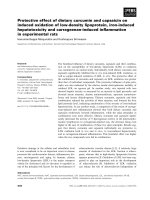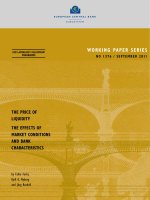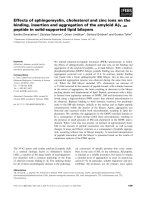Effects of dietary protein and lipid levels an
Bạn đang xem bản rút gọn của tài liệu. Xem và tải ngay bản đầy đủ của tài liệu tại đây (111.05 KB, 1 trang )
Nilnaj Chaitanawisuti, Sirusa Kritsanapuntu, Wannanee Santaweesuk, 2011.
Effects of dietary protein and lipid levels and protein to energy ratios on growth
performance and feed utilization of hatchery-reared juvenile spotted babylon
(Babylonia areolata). Aquaculture international. 19(1):13-21.
Abstract
A 120-day feeding trial was designed to determine the effects of different dietary
protein and lipid levels and protein to energy ratio (P:E) on growth performance
and feed utilization of hatchery-reared juvenile spotted babylon, Babylonia
areolata, cultured under a flow-through seawater system. Six diets were formulated
to contain three protein levels (18, 28, and 36%) and two lipid levels (10 and 15%)
in a 3×2 factorial design with three replicates to provide six different dietary P:E
ratios (50.17, 49.09, 68.50, 65.85, 88.66, and 85.36mg protein/kcal). Each replicate
was stocked with 50 snails (0.12+0.01g, initial weight) and fed to satiation once
daily. The results showed that survival was above 96% at the end of the feeding
trial in all groups and was not affected by either dietary protein level or dietary
lipid level. The highest significant (P<0.05) growth and feed utilization were
observed for juveniles fed diet with a P:E ratio of 88.66kcalg−1 diet. With respect
to dietary protein and lipid levels, the highest (P<0.05) values for growth and feed
efficiency were observed for snails fed a diet containing 36% protein level and the
same trend was observed for snails fed a diet with 10% lipid level. This results
indicated that the diet containing 36% protein and 10% lipid level with a dietary
P:E ratio of 88.66mg protein/kcal would be suitable for optimum growth and feed
utilization of B. areolata juveniles. Keywords Babylonia areolata –Protein–Lipid–
Protein/energy ratio–Growth performance.









